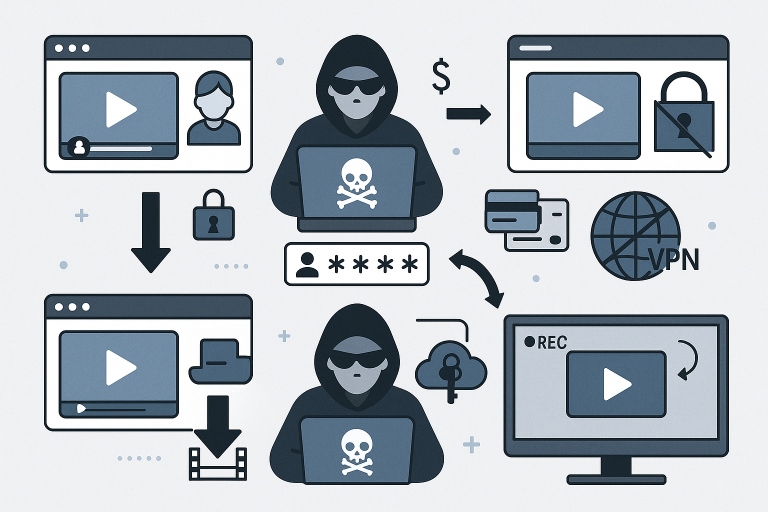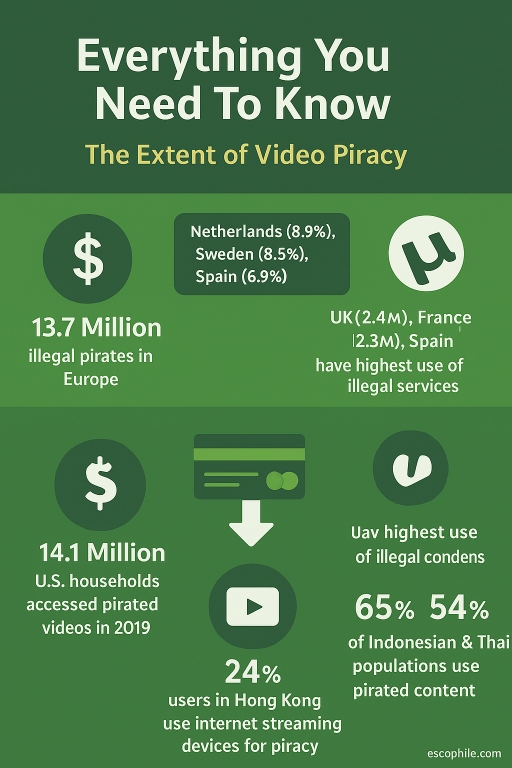Table of Contents
ToggleIs video piracy draining your revenue in 2025? Discover how AI, encryption, and legal tools can protect your content from credential theft, illegal streams, and digital pirates—before it’s too late. For video content creators and businesses, piracy isn’t just a threat—it’s a $40–97.1 billion drain on the film industry alone, with illegal streaming consuming 24% of global bandwidth.
Key Takeaways:
AI Is Your Best Ally: Use AI-powered tools for real-time piracy detection, automated DMCA takedowns, and identifying deepfake-altered content.
Upgrade to Quantum-Ready DRM: Traditional encryption isn’t enough—deploy quantum-resistant DRM like DeepMind Shield to stay ahead of AI cracking bots.
Watermark Everything: Embed invisible, user-specific IDs (IP/email) to trace leaks and deter sharing—especially for high-value content.
Leverage Global Laws: Enforce rights with tools like the EU’s Digital Services Act and fast-track DMCA protocols for 6-hour takedowns.
Think Like a Pirate (and Then Out-Secure Them): Pirates value convenience and price—offer tiered pricing, fast UX, and mobile-first access to win them over.
Credential Sharing Is Still Leaking Revenue: Block multi-device abuse with MFA, session ID limits, and geo-IP restrictions.
Anti-Piracy = Profit Protection: Ignoring piracy can cost you 15%+ of your revenue—investing in protection is a proven ROI-positive move.
Stay Region-Aware: Hotspots like the Netherlands, Indonesia, and Hong Kong need tighter geo-blocking, watermarking, and legal focus.
Use Multi-Layered Defense: Combine secure hosting, DRM, watermarking, domain locking, and analytics for a robust piracy-proof ecosystem.
How Video Piracy Works in 2025: Tactics, Risks & Solutions
Video piracy drains revenue through credential sharing, illegal downloads, and live stream hijacking. Here’s how hackers exploit vulnerabilities and how to stop them:

1. Credential Sharing: The Silent Revenue Killer
Platforms like Netflix and Disney+ Hotstar lose millions to password freeloading. Beyond casual sharing, hackers use advanced tactics:
Password Theft: Steal credentials via phishing or dark web sales.
Fake Accounts: Use stolen credit cards to create free access hubs.
Token Hijacking: Copy authentication codes to bypass device limits.
Server Manipulation: Hack synchronization controls to enable unlimited logins.
Fix It: Deploy AI-driven anomaly detection to flag suspicious logins and enforce multi-device authentication.
2. Video Downloading: Bypassing Encryption
Pirates exploit weak encryption key security or use tools like YouTube downloaders to rip content. Common methods include:
Key Extraction: Decrypt videos by targeting poorly secured encryption keys.
Storage Platform Breaches: Hack pre-release content from third-party servers.
Fix It: Partner with DRM providers like Google Widevine and adopt dynamic watermarking to trace leaks.
3. Live Streaming Piracy: The 51% Problem
Per SportsPro, 51% of sports fans watch pirated streams. Hackers hijack live broadcasts via:
Screen Recording: Capture during playback or screen-sharing.
Credential Stuffing: Use leaked emails/passwords to access paid streams.
VPN Abuse: Circumvent geo-restrictions to redistribute content.
Fix It: Use real-time blockchain watermarking and geo-fencing to block unauthorized access.
AI vs. AI: The 2025 Piracy Arms Race (And How to Win It)
Pirates now weaponize AI to hijack content—altering videos, bypassing DRM, and flooding the web with illegal streams. Here’s how to fight back:
AI Piracy Tactics in 2025: 4 Emerging Threats
Deepfake Evasion: Neural networks tweak video fingerprints (e.g., color grading, audio pitch) to dodge copyright bots.
DRM Cracking Bots: AI brute-forces encryption keys 100x faster than humans, ripping 4K streams from Netflix/Disney+.
Cloud Piracy Networks: Auto-scaling AWS/Azure servers host illegal streams, evading regional shutdowns.
AI Content Scouts: Bots scrape platforms like YouTube for trending videos, pirating them within minutes.
Fight AI with AI: 2025’s Anti-Piracy Arsenal
Real-Time Tamper Detection: Tools like Pex or Vobile use AI to spot deepfake-altered frames.
Quantum Encryption: Deploy quantum-resistant DRM (e.g., Google’s DeepMind Shield) to block brute-force attacks.
Blockchain Watermarking: Embed immutable, AI-proof IDs to trace leaks to the source.
Automated Takedowns: AI sends DMCA notices within seconds of detecting piracy.
Copyright Laws in 2025: Your Legal Shield Against AI-Powered Piracy
As pirates weaponize AI, global laws are your first line of defense. Here’s how to leverage 2025’s legal frameworks:
1. 2025’s Global Copyright Upgrades
DMCA Takedowns: Still the gold standard—remove pirated content in under 6 hours with properly formatted notices.
EU’s Digital Services Act (DSA): Fines platforms like TikTok up to 6% of global revenue for hosting illegal streams.
Berne Convention Gaps: Cross-border enforcement lags; a leak in Indonesia? Local laws may delay takedowns by weeks.
2. 3 Legal Weapons for Creators
AI-Powered Scans: Tools like Pex auto-detect piracy and generate DMCA notices.
Sue to Silence: Target “repeat infringer” sites (e.g., PirateBay clones) to bankrupt their operations.
Platform Partnerships: Netflix and YouTube now share piracy data with rights holders under DSA rules.
Anti-Piracy ROI in 2025: Protect Profits or Lose 15% of Revenue?
Ignoring piracy costs more than fighting it. Studies show brands lose 15%+ revenue without protection. Here’s how to calculate ROI and justify anti-piracy spending:
1. Quantify Losses: The 3-Step Formula
Pirated Views: 100K illegal streams × $0.10/ads = $10K/month loss.
Subscriber Churn: 5% cancel pay-TV due to free leaks = $50K/year gone.
Brand Damage: Negative SEO from pirated copies? SEO recovery costs $20K–$100K.
2. Cost vs. Savings: Anti-Piracy Tools Breakdown
DRM Solutions: Google Widevine ($0.05/video) vs. Apple FairPlay ($0.10/video).
Forensic Watermarking: $500/month (e.g., Vobile) tracks leaks to exact users.
AI Monitoring: Pex ($299/month) scans 100+ platforms for stolen content.
3. Proven ROI: Real 2025 Wins
Streaming Giant Case: Blocked 2M pirated views/month with DRM + watermarking = $2M/year saved.
Indie Filmmaker Hack: Spent $1K on AI monitoring → Recovered $15K in leaked course sales.
The Psychology of Piracy in 2025: Why Users Steal & How to Win Them Back
Piracy isn’t just about free content—it’s a rebellion against poor accessibility and pricing. Here’s how to flip the script:
1. Why People Pirate: The 2025 Mindset
Cost Barriers: 42% of pirates earn under $30K/year (MPAA Study, 2024)—they can’t afford 5+ streaming subscriptions.
Convenience Wars: Pirate sites offer no-ads, offline access—Netflix’s $6.99 ad tier cut piracy by 18% in test markets.
“Fairness” Factor: Fans pirate shows unavailable locally (e.g., Anime in Europe pre-Crunchyroll).
Awareness Gap: 33% don’t know piracy harms creators (RIAA Survey, 2023).
2. The Fix: Convert Pirates into Paying Fans
Tiered Pricing: Offer $3.99/month mobile-only plans (like Spotify in India).
UX Overhaul: Beat pirates with buffer-free 4K, TikTok-style discovery feeds.
Guilt-Free Marketing: YouTube’s “Creators Lose” ads reduced piracy intent by 27%.
Reward Loyalty: Early access to Stranger Things episodes for 2-year subscribers.
Video Piracy in 2025: The Global Crisis (And How to Fight It)
Measuring video piracy’s global impact is notoriously complex, but regional data reveals alarming trends. Here’s what businesses need to know:
1. Europe’s Piracy Hotspots
13.7 million EU users accessed illegal services, per the European Intellectual Property Office.
Top Offenders: Netherlands (8.9%), Sweden (8.5%), and Spain (6.9%) surpass the EU average (3.6%).
High-Risk Markets: UK, France, and Spain lead in regular illegal service users.
2. North America’s Gray Zone
Conflicting Data: Sandvine reports 6.5% of households use pirate sites, while Park Associates estimates 14.1 million US households (16% of pay TV market) accessed pirated videos in 2019.
3. Asia’s 45% Problem
University of Amsterdam Study: Indonesia (65%) and Thailand (54%) have the highest piracy rates.
Asian Video Industry Association (2019):
Hong Kong: 24% use illegal streaming devices.
Philippines: 28% | Taiwan: 34% | Thailand: 45%.

Video Piracy’s $71B Impact: How It Cripples Economies in 2025
Video piracy isn’t just stealing content—it’s draining $52B+ globally (Digital Television Research) and sabotaging jobs, licensing deals, and innovation. Here’s the breakdown:
1. Economic Collateral Damage
US Losses: $29.2B–$71B/year (US Chamber of Commerce) in film/TV revenue, with GDP losses hitting $47B–$115B (Blackburn et al., 2019).
Global Domino Effect: By 2023, piracy could cost $67B worldwide (Parks Associates), including $6B from pay-TV cancellations.
2. Licensing & Distribution Breakdown
Pirated content scares off investors. Example:
Is a Netflix show leaking early? Distributors skip licensing deals, fearing free access hurts ROI.
3. The 230B Illegal Views Problem
US Dominance: 12.8B views of pirated TV episodes domestically; 170.6B views abroad.
Top Pirate Hubs: Sites like PirateBay serve 59M users daily with stolen Netflix, Disney+, and Prime Video content.
4. Credential Sharing’s Hidden Cost
5% of US households hijack pay-TV logins; 6% steal streaming passwords (Parks Associates).
Stop Video Piracy in 2025: 7 Proven Strategies to Protect Your Content
Pirates often pay for content—if you deliver value. Platforms like Netflix prove that personalized recommendations and affordable pricing reduce piracy. Here’s how to safeguard your videos in 2025:
1. Block Credential Sharing
WordPress Sites: Use plugins like WP Limit Sessions to block simultaneous logins. Pair with managed WordPress hosting for robust security.
Non-WordPress Sites: Assign unique session IDs to prevent multi-device access.
SSO Integration: Let users log in via Google/Facebook—fewer shared passwords, better UX.
2. Restrict Playback
Limit viewing time per user (e.g., 24-hour access windows) to curb unauthorized sharing.
3. Encrypt Videos
AES-128: Basic encryption for low-risk content.
HLS + AES-128: Secure streaming for high-value videos.
4. Upgrade to DRM
Encryption keys are vulnerable—add Google Widevine or Apple FairPlay DRM to lock down content with license servers and user authentication.
5. Dynamic Watermarking
Embed invisible user-specific IDs (IP, email) to trace leaks.
6. Domain Locking
Restrict embeds to your domain only—hackers can’t reuse codes.
7. Secure Hosting
Choose platforms offering:
DRM & CDN (e.g., Vimeo Enterprise, Brightcove).
Video Analytics: Track piracy red flags (e.g., unusual view spikes).
Inkrypt Videos: 2025’s All-in-One Anti-Piracy Solution for Creators
Inkrypt Videos combats piracy with military-grade encryption, AI-powered analytics, and customizable security tools. Here’s how it protects your content:
1. Fort Knox-Level Encryption
AES-256 & DRM: Shield videos with unbreakable encryption and license-based access (e.g., HLS/DASH protocols).
Domain Locking: Restrict embeds to your website—no unauthorized reuse on pirate sites.
2. Trace & Deter Pirates
Dynamic Watermarking: Embed invisible user IDs (IP, email) to pinpoint leaks.
Real-Time Analytics: Detect suspicious activity (e.g., 100+ views from one account).
3. User-Friendly Playback
Customizable Player: Add subtitles, speed controls, and chapter markers without compromising security.
4. 2025-Ready Features
AI Piracy Alerts: Get notified if your content appears on illegal platforms.
Multi-Device Blocking: Limit logins across smartphones, tablets, and PCs.
Netflix’s 2025 Password Crackdown: Will It Stop Piracy & Boost Revenue?
Netflix is tackling 100 million shared accounts with a global paywall for out-of-household users. Here’s the strategy, risks, and what it means for creators:
1. The $6B Revenue Gamble
Extra Fees: Charge non-household users ~$7.99/month (varies by region) to share accounts.
Goal: Convert freeloaders into paying subscribers—Netflix estimates $6B+ revenue potential.
2. The Subscriber Risk
Cancellation Fears: 23% of users threaten to quit if forced to pay (Forbes, 2023).
Balancing Act: Will new sign-ups offset losses? Early data from Latin America shows mixed results.
3. Anti-Piracy Tech Behind the Scenes
AI Detection: Monitor IP addresses, device IDs, and viewing patterns to flag shared accounts.
Two-Step Verification: Require OTPs for devices outside the primary household.
Netflix’s 2025 Password Crackdown: How Verification Codes & Fees Stop Freeloaders
Netflix is tightening its grip on shared accounts with two-factor authentication (2FA) and paywalls. Here’s how it works:
1. The 15-Minute Verification Rule
Device Checks: If you log in from an unrecognized device/location, Netflix sends a 4-digit code to the account owner’s email/phone.
Time Limit: Enter the code within 15 minutes—or get locked out.
2. The “Pay or Block” Strategy
Failed Verification? Users must upgrade to an “Extra Member” sub-account (~$7.99/month) to keep watching.
Recognized Devices: Smart TVs or laptops used at the “home” location bypass checks.
3. Behind the Scenes: AI & IP Tracking
Home Base: Netflix uses Wi-Fi IP addresses and device IDs to flag logins outside the primary household.
Behavior Analysis: Unusual viewing patterns (e.g., simultaneous logins in different cities) trigger alerts.
Conclusion:
Video piracy in 2025 is more advanced—and more costly—than ever. From AI-powered theft to global content leaks, creators and businesses can no longer afford to stay passive. Fortunately, the right mix of technology, legal action, and user-focused strategies can significantly reduce your risk, protect your revenue, and even win back would-be pirates as paying fans.
Ready to secure your content and future-proof your revenue? Start implementing AI-driven anti-piracy tools, upgrade to quantum-safe DRM, and educate your audience today.
Don’t wait—protect what you create.
FAQs
What are the best ways to stop video piracy in 2025?
Use DRM encryption, forensic watermarking, domain restrictions, and user authentication to secure video content from unauthorized access and copying
How does forensic watermarking help prevent video piracy?
It embeds unique, invisible marks in videos to trace leaks and identify pirates, deterring illegal redistribution and enabling targeted counteractions
Why is DRM important for protecting video content?
DRM encrypts videos to prevent unauthorized downloads and streaming, ensuring only licensed users can access the content securely
How can playback restrictions reduce video piracy?
Geo-blocking, device limits, and concurrent stream restrictions control where and how many devices can access videos, limiting unauthorized sharing
What role does user authentication play in video piracy prevention?
It verifies user identity to restrict access, prevent password sharing, and enforce usage policies, reducing unauthorized content distribution
When should content creators implement anti-piracy measures?
Anti-piracy strategies should be integrated from content creation through distribution to maximize protection and revenue retention
How can video analytics support anti-piracy efforts?
Analytics track viewing patterns to detect suspicious activity, helping identify piracy risks and enabling swift remedial actions
How does dynamic watermarking differ from static watermarking?
Dynamic watermarking changes marks per viewer or session, making piracy tracking more precise than static, uniform watermarks
Can IP blocking help stop video piracy?
Yes, IP blocking restricts access from suspicious or blacklisted IP addresses, reducing unauthorized viewing from certain regions
Is video piracy more common in specific regions?
Piracy prevalence varies by geography, often higher where enforcement is lax; geo-restrictions help manage access accordingly
What technologies detect password sharing on streaming platforms?
Advanced monitoring tools analyze concurrent streams and device usage to flag and limit password sharing
Are there specific anti-piracy strategies for DVD content?
Yes, DVD piracy requires tailored measures like physical copy protection and digital encryption to prevent illegal duplication


